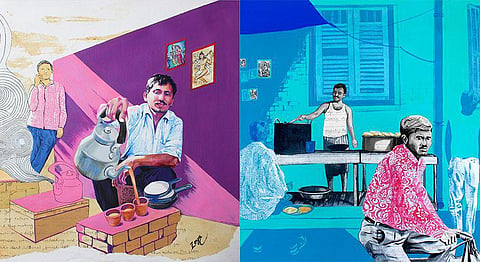
- HOMEGROWN WORLD
- #HGCREATORS
- #HGEXPLORE
- #HGVOICES
- #HGSHOP
- CAREERS
- ABOUT US
- CONTACT US

An Indian city’s spirit is embodied in its streets. The bustling crowds are the essential element of the city’s genetic fabric. But if you look close enough, it’s the many street vendors, shop owners and everyday hustlers that truly capture the street’s wonderful essence.
‘Many Streets Many Wonders’ by Zoya Chaudhary beautifully captures the vibrant nature of Indian cities. From the charming chaiwala to the local barber, these illustrations are a colourful and stylistic glimpse into India’s grass-root life and culture. The artist who is now based in Singapore, made this series as an ode to the vibrant magic of the streets. We had a chance to speak the artist about her inspirations, creative process and more!
Tell us about your project.
Ever since I moved out of India, I have lived with the fear that the smells, sounds and sights familiar to me would gradually disappear, as they have in other modernised cities of the world. To sell global products, the media also sells ideas, often one-sided and creates unjustifiable fascinations with modern ways of life, that hardly represent a natural progression for many vanishing cultures and communities around the world. The thought of the impersonal ‘mall culture’, that is fast taking over the world, where people are hidden behind brands and digitisation, where a laundry app turns your ‘dhobi’ into a button, gave birth to my series ‘Many Streets Many Wonders’. The series visually documents the local culture that I grew up in and am often nostalgic about.
I’ve used a mix of paints, ink and cut-outs from my old notebooks (to put in a piece of myself) from when I used to be in India, as well as newsprint cut-outs to create the textures. I have used a minimal palette of 3-4 colours to achieve a flat graphic effect.
‘HG loves’ the use of colour and details to capture the diverse characters and nuances of the authentic street culture.
What are some of your biggest inspirations over the years of your artistic career?
As a student of Applied arts, I was trained in Communication Design & Illustration, so my method comes from there. My father was a screen writer during the early years of Doordarshan and I saw him create characters and stories from real life people and experiences. One example would be the TV show ‘Nukkad’, where the characters of the show like ‘Kader bhai’, ‘Chaurasiya Paanwala’ and a few others were inspired by real characters (with the same names) from our locality in Juhu. Looking back, I think my interest in human stories was planted during that time. In my late teens and early 20’s, along with pursuing my career in design, I was also involved in theatre in Mumbai and my experiences there and the people I worked with, have played a big part in my growth as an artist. My inspirations kept changing over time. Early inspirations used to be Van Gogh, Picasso and many expressionist artists, whose books were available in India in the 90’s. I was particularly drawn to screen printed graphic art and illustrations of the 70s and 80s, that had a bold graphic feel due to the limited colour palette used. Later as the internet opened the world up, inspirations were not limited to a few artists and came from all over. I have also, always drawn inspiration from written words, books and news. A recent obsession, has been the graphic novels of Marjane Satrapi and Alan Moore.
Describe your creative process and the purpose with which you create.
It starts with a thought usually lingering somewhere in my mind, which I then feed slowly and gradually. I usually make many notes on what I would like to work on, the intention, purpose and form. Some ideas die an early death, while others stay put. I then collect relevant references, texts, newsprint cuttings and pattern drawings. Then comes the sketching, painting, making patterns and collages. I usually end up using pencil, inks and paint all together for a single artwork, many a times blurring the line between the mediums. I usually try to take a lighthearted approach at making my point.
What is the first piece of art/photograph/film/music that impacted you deeply?
Iranian film ‘Children of Heaven’ by Majid Majidi, that I had seen in my teens, made a huge impact on me.
If you could propose and lead a project with the Indian Government, what would it be?
I have always been captivated by the idea that people/community/country is always in danger of being reduced in stature, if seen by a single lens, single story or a single symbol. I would propose to build a committee of artists, writer, historians, film makers and culturists to work on unbiased documentation of diverse regional groups, languages, local histories & stories that truly celebrate the diversity of India, instead trying to impose one single story and narrative, silencing the many others that have played a vital role in weaving the fabric of this truly unique & diverse democracy called India.
Which is your favourite piece of work of your own & why?
I’m detached and move on quickly once an artwork is done, so usually, the project I’m working on, at any given time, is my favourite.
On a personal note -
One track you’re currently listening to?
‘Shallow’ from the movie ‘A Star is Born’.
‘Bol ke lab azad hain tere’ from the movie ‘Manto’.
A project you wish you were a part of?
Fearless project by artist Shilo Shiv Suleiman.
Your favourite midnight munchies?
I’m a morning person, so no mid-night munchies for me.
Your greatest vice?
Tea.
If you liked Zoya’s work, check out his Instagram here.
If you liked this article, we suggest you read:
